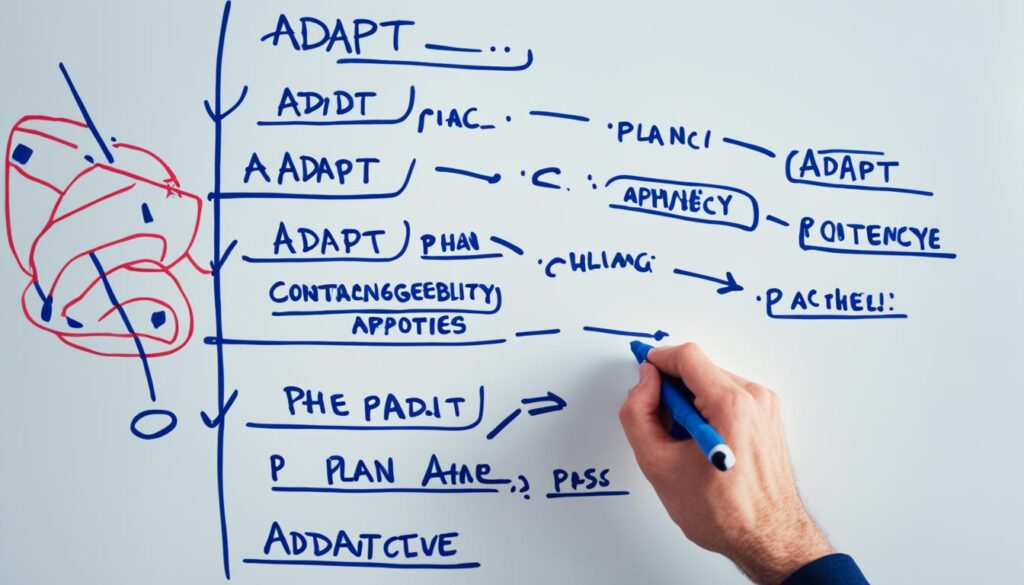Contingency Approach to Goal Setting: Adapt & Achieve

Have you ever wondered why some leaders excel in certain situations while faltering in others? Is there a secret formula that determines their success? The answer lies in the contingency approach to goal setting.
This approach recognizes that leadership is not a one-size-fits-all concept. It acknowledges the importance of adapting management approaches and strategies based on the specific needs of each situation. By understanding the elements of the contingency approach and considering situational factors, leaders can optimize their success in achieving organizational goals.
From Fiedler’s contingency model to the path-goal theory of leadership, this article explores various contingency theory models and their practical application. We will delve into different management styles and how they align with specific situations. Furthermore, we will discuss the process of developing a contingency plan to ensure preparedness for any potential challenges that may arise.
Get ready to unlock the secrets of successful leadership. Are you ready to master the art of adaptability and achieve your goals? Let’s dive in!
Key Takeaways:
- The contingency approach to goal setting emphasizes matching leadership style to the specific situation.
- Contingency theory models provide frameworks for understanding and implementing the contingency approach.
- There are different types of management styles suited for various situations.
- Implementing contingency theory requires flexibility, adaptability, and understanding the unique needs of each situation.
- Developing a contingency plan ensures preparedness for potential risks and challenges.
Understanding Contingency Theory
Contingency theory is an essential concept in leadership that focuses on the match between leadership style and the specific situation. It acknowledges that no single leadership style can effectively address all scenarios. Situational factors play a crucial role in determining the appropriate leadership approach, considering aspects such as the complexity of the environment, the capabilities of team members, and the nature of the task at hand.
Unlike traditional theories that advocate a one-size-fits-all approach to leadership, contingency theory emphasizes the need for leaders to adapt their style based on the unique circumstances they face. By doing so, leaders can effectively navigate different situations and optimize their effectiveness in achieving organizational goals.
Various contingency theory models provide valuable frameworks for understanding and implementing the contingency approach to goal setting. These models include:
- Fiedler’s contingency model
- Situational leadership theory
- Path-goal theory of leadership
- Vroom-Yetton-Jago model of decision-making
- Contingency model of conflict resolution
- Contingency approach to organizational design
Each of these models offers unique insights into the relationship between leadership style, situational factors, and goal attainment. By comprehending and leveraging these models, leaders can make informed decisions and create strategies that are tailored to the specific context they operate in.

Benefits of Contingency Theory
Contingency theory brings several benefits to leadership and organizational effectiveness:
- Flexibility: It encourages leaders to be flexible and adaptive, allowing them to respond effectively to the changing demands of diverse situations.
- Enhanced decision-making: By matching leadership style to the situation, leaders can make informed decisions that align with the needs of their team and organization.
- Improved performance: The contingency approach helps leaders optimize their performance by leveraging the strengths and capabilities of their team members and tailoring their leadership style accordingly.
- Inclusive approach: It recognizes that different situations require different leadership styles, promoting inclusivity and diversity in leadership practices.
By understanding and implementing contingency theory, leaders can navigate the complexities of the modern business environment and build successful organizations.
| Contingency Theory Model | Description |
|---|---|
| Fiedler’s contingency model | Matches the leader’s natural style to situational factors to determine effectiveness. |
| Situational leadership theory | Matches the leader’s style to the maturity level of their followers. |
| Path-goal theory of leadership | Emphasizes the impact of followers’ characteristics and task demands on the leader’s effectiveness. |
| Vroom-Yetton-Jago model of decision-making | Considers the nature of the decision, the level of information available, and follower involvement in the decision-making process. |
| Contingency model of conflict resolution | Identifies the most effective conflict resolution strategy based on the situation. |
| Contingency approach to organizational design | Tailors organizational design to align with situational factors and achieve optimal performance. |
Different Types of Management Styles
Good managers understand the importance of adapting their management style to fit the specific needs of each situation. There are various types of management styles that leaders can employ to effectively lead their teams. Each style possesses unique characteristics and is suited for different scenarios. Let’s explore some of the key management styles:
- Autocratic Management: In this style, the leader maintains full control and makes decisions without seeking input from their team. This approach may be appropriate in situations that require quick and decisive actions.
- Democratic Management: This style emphasizes collaboration and involvement of team members in decision-making processes. It fosters a sense of empowerment and encourages teamwork.
- Laissez-Faire Management: Leaders who adopt this style provide autonomy to their team members and delegate authority. It promotes individual creativity and innovation, but may require strong self-motivation within the team.
- Transformational Management: This style focuses on inspiring and motivating team members to achieve higher levels of performance. Leaders who exhibit transformational management instill a shared vision, encourage personal growth, and foster positive change.
- Transactional Management: This style revolves around a clear structure of rewards and punishments. Leaders set expectations and establish performance goals, offering incentives and disciplinary measures accordingly.
- Servant Leadership: Leaders who utilize this style prioritize the needs and well-being of their team members. They take on a supportive role, empowering individuals to reach their full potential.
- Coaching Leadership: In this style, leaders focus on developing the skills and capabilities of their team members through mentorship and guidance. Continuous learning and growth are key principles of coaching leadership.
- Charismatic Leadership: This style relies on the leader’s charm, persuasion, and ability to motivate others through their personal qualities and vision. Charismatic leaders inspire loyalty and commitment among their followers.
- Bureaucratic Management: This style places importance on adherence to rules, procedures, and established protocols. It ensures consistency, uniformity, and compliance within the organization.
- Situational Leadership: This style requires leaders to adapt their management approach based on the specific circumstances and needs of the situation. It emphasizes the importance of flexibility and versatility.
The contingency approach to goal setting recognizes that different situations demand different management styles. By understanding and leveraging various management styles, leaders can effectively navigate challenges, motivate teams, and achieve their organizational goals.

Putting Contingency Theory Models into Practice
Implementing the principles of contingency theory models is essential for applying the contingency approach to goal setting effectively. Let’s explore some prominent models and their practical applications:
Fiedler’s Contingency Model
Fiedler’s contingency model focuses on matching the leader’s natural style with situational factors. These factors include leader-member relations, task structure, and leader position power. By understanding the dynamics of these variables, leaders can determine the most suitable leadership style for a given situation.
Situational Leadership Theory
Situational leadership theory suggests that effective leadership involves matching the leader’s style to the maturity level of their followers. Leaders must assess their followers’ competence and commitment and adjust their leadership approach accordingly. This model highlights the importance of adaptable leadership behaviors.
Path-Goal Theory of Leadership
The path-goal theory of leadership emphasizes that a leader’s effectiveness depends on followers’ characteristics and task demands. Leaders should identify the needs and goals of their followers and provide the necessary support and guidance to achieve those goals. This model helps leaders navigate different situations by tailoring their actions to facilitate followers’ success.
Vroom-Yetton-Jago Model of Decision-Making
The Vroom-Yetton-Jago model of decision-making explores how leaders can effectively make decisions in various situations. It considers the nature of the decision, the level of information available, and the degree of follower involvement in the decision-making process. By understanding these factors, leaders can determine the most appropriate decision-making style to achieve the desired outcomes.
Contingency Model of Conflict Resolution
The contingency model of conflict resolution recognizes that conflict is inevitable in organizations. It proposes that the most effective conflict resolution strategy depends on the situation. Leaders must carefully assess the nature and context of the conflict and choose the most appropriate approach to resolve it. This model empowers leaders to manage and resolve conflicts efficiently.
Implementing these contingency theory models requires leaders to embody flexibility, adaptability, and a deep understanding of the specific needs of each situation. By applying these models in practice, leaders can make informed decisions, resolve conflicts, and optimize their leadership effectiveness.

| Contingency Theory Models | Key Focus Areas | Practical Application |
|---|---|---|
| Fiedler’s Contingency Model | Leader-member relations Task structure Leader position power |
Matching leadership style with situational factors |
| Situational Leadership Theory | Followers’ competence and commitment Task demands |
Adapting leadership approach based on followers’ maturity level |
| Path-Goal Theory of Leadership | Followers’ needs and goals Task demands |
Providing support and guidance to facilitate followers’ success |
| Vroom-Yetton-Jago Model of Decision-Making | Nature of the decision Information availability Follower involvement |
Determining appropriate decision-making style |
| Contingency Model of Conflict Resolution | Nature and context of the conflict | Choosing the most effective conflict resolution strategy |
Developing a Contingency Plan
In order to effectively navigate dynamic business environments and optimize organizational performance, developing a contingency plan is crucial. This plan ensures that your business is prepared to address potential risks, challenges, and uncertainties, while still working towards achieving your objectives and goals. Let’s explore the essential steps involved in creating a comprehensive contingency plan.
1. Assessing Business Needs
The first step in developing a contingency plan is to thoroughly assess your business needs. This involves identifying your key objectives, goals, and the desired outcomes you want to achieve. By clearly understanding your business needs, you can develop effective strategies to address any potential disruptions that may arise.
2. Identifying Potential Risks and Challenges
Next, it is important to identify potential risks and challenges that could impact your business operations. This includes considering both internal and external factors, such as equipment failures, market fluctuations, natural disasters, or changes in regulatory requirements. By anticipating potential risks, you can proactively develop strategies to mitigate their impact.
3. Creating Contingency Strategies and Action Plans
Based on the identified risks and challenges, it is crucial to develop contingency strategies and action plans. These plans outline the specific steps that need to be taken when a particular risk or challenge arises. Each contingency strategy should include clear objectives, tasks, and timelines to guide your team in addressing the issue effectively.
4. Assigning Roles and Responsibilities
Assigning roles and responsibilities is a critical component of plan implementation. By clearly defining the key responsibilities of each team member, you ensure that everyone understands their role in executing the contingency plan. This promotes effective coordination and swift action when responding to potential disruptions.
5. Implementing the Contingency Plan
Once the contingency strategies and action plans have been developed, it is time to implement the plan. This involves putting the strategies into practice and executing the predefined steps when a risk or challenge occurs. Effective plan implementation is essential for minimizing disruption and maintaining business continuity.
6. Communication, Training, and Development
Ensuring effective communication is vital during the plan implementation phase. This involves keeping all stakeholders informed about the contingency plan, their roles, and the steps taken to address potential risks. Additionally, providing training and development opportunities for your team members enables them to better understand the plan and enhances their ability to respond and adapt to changing situations.
7. Monitoring and Adjustment
A contingency plan is not a one-time document but an ongoing process. It is crucial to continuously monitor its effectiveness and make adjustments as needed. Regularly evaluating the outcomes and response to potential risks allows for refinements and improvements, ensuring that your plan remains relevant and adaptable.

Conclusion
The contingency approach to goal setting is critical for leaders to achieve success in today’s dynamic and complex business environment. It emphasizes the need for flexibility, adaptability, and matching the leadership style to the specific situation. By understanding and applying various contingency theory models and choosing the right management style based on situational factors, you can make effective decisions, optimize organizational structure, and foster a culture of flexibility and adaptability.
The contingency approach to goal setting enables you to embrace change, navigate challenges, and ultimately achieve your goals. By leveraging the strengths of different leadership styles, considering situational factors, and making effective decisions, you can create a conducive organizational structure that promotes success and growth. It is through this approach that you can cultivate a culture of innovation and resilience, which is essential for addressing the ever-evolving demands of today’s business landscape.
Implementing the contingency approach to goal setting not only leads to improved organizational performance but also enhances employee satisfaction. When leaders demonstrate flexibility and adaptability, employees are more likely to feel supported, motivated, and engaged. The ability to tailor leadership styles and management approaches to the specific needs of each situation fosters a sense of ownership and trust among team members, leading to higher productivity and the achievement of desired outcomes.
In conclusion, the contingency approach to goal setting is a powerful tool for leaders who aspire to success. By embracing this approach, you can effectively navigate dynamic and challenging business environments. Through the integration of flexibility, adaptability, and effective decision-making, you can optimize organizational structure, foster employee satisfaction, and achieve your goals.






